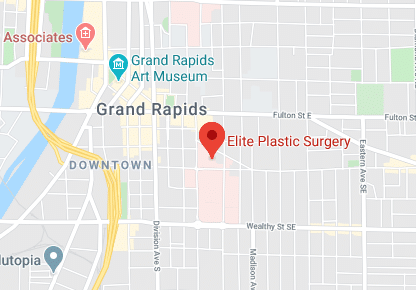
How is breast reconstruction done?
As noted above, there are two methods used in breast reconstruction. Which method is used can depend on whether there is enough tissue left on the chest wall to adequately hold and cover an implant.
Here are how the two methods are performed:
-
- Implant/Tissue-Expansion Reconstruction
Once the breast has been removed, there isn’t enough tissue to hold an implant. The goal with this method is to stretch the skin to avoid having to transplant tissue from another area of the body to the chest. The first step is for your Elite surgeon to insert a balloon expander beneath the skin and chest muscle where the reconstructed breast will be formed. Over the course of a few weeks or months, saline solution is injected through a tiny valve beneath the skin into the expander. As it fills with the saline solution, the expander stretches the skin, creating a pocket for the implant. Once the expander has achieved the desired size it can be left in place, serving as the implant, or it can be replaced with another saline or silicone implant. The final step is reconstruction of the areola and nipple.
-
- Autologous-Tissue Reconstruction
If the patient doesn’t have enough tissue for expansion to be successful, or if she doesn’t have any interest in having an implant, autologous-tissue reconstruction is done. In essence, your Elite surgeon creates a breast using skin, fat, and muscle taken from elsewhere on the body. The abdomen, back, buttocks, and thighs are typical donor locations. The donor tissue is called a “flap.” It is either surgically removed and reattached (this is a free flap) on the chest, or it is left connected with its blood supply and that blood supply is re-routed to the new location on the chest (pedicle flap). During a free flap procedure, the blood supply needs to be reattached to the muscle and skin for it to survive. Various flap techniques can be employed depending on where the best donor tissue is located, the ability to relocate blood vessels, the desired size of the reconstructed breasts, and other factors. The final step is to recreate the areola and nipple through grafting.
I may need chemotherapy; can I still have breast implants?
In the past, it was believed that you needed to wait to have breast reconstruction surgery until the patient finished with chemotherapy. That thinking has changed. New research indicates that breast reconstruction with either breast implants or flap reconstruction is completely safe if you are undergoing chemotherapy.
There also is a side benefit to moving ahead with reconstruction even if you could need future chemotherapy. Many chemotherapy patients who choose to have immediate breast reconstruction report that regaining their figure helps boost their confidence and gives them extra energy as they are undergoing chemo treatments.
Would you like to talk to one of our plastic surgeons about reconstruction? Call us at Elite Plastic Surgery, (616) 459-1907, to schedule a consultation.


Comments are closed.